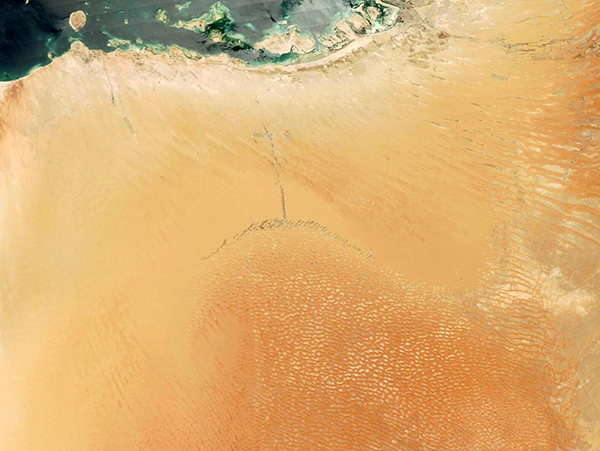Images
August 31, 2022 - Liwa Oasis and the Rub' al Khali Desert
Tweet
Liwa Oasis, a rich, green expanse of trees and towns, rises suddenly from the vast expanse of dry, undulating, tan-toned desert of the United Arab Emirates. Seen from space, this lush oasis forms the long curving arc of the green “T” that sits at the northern edge of the apricot-tinted dunes of the Rub’ Al Khali (Empty Quarter)—the Earth’s largest uninterrupted desert. The long straight line of the “T” marks greenery, including date trees, planted along highway E45.
Rainfall is scarce in the region, so the greenness of the Liwa Oasis comes almost entirely from a water table that lies close to the surface. This natural reservoir has been called “fossil” water, as some estimates suggest it accumulated more than 20,000 years ago, with the bulk of it now buried under limestone formations and sand.
The Liwa Oasis is the ancestral home of the Bani Yas tribe, the most numerous and significant tribe in the United Arab Emirates, according to the Abu Dhabi Culture website. In the past, the traditional practice of the Bani Yas tribe was raising camels and other livestock, and farming dates and other crops within the oasis. In the summer, they would trek about 62 miles (100 km) to reach their fleets of boats along the coast of the Persian Gulf to gather precious pearls. Pearl diving was once the mainstay of the economy of the United Arab Emirates and other Persian Gulf countries. According to Business Insider, pearl exports made up 75 percent of the Persian Gulf’s exports at the end of the 19th century. However, the onset of pearl farming in the 1930s triggered a rapid decline of pearling in the Gulf.
The Moderate Resolution Imaging Spectroradiometer (MODIS) on board NASA’s Terra satellite acquired a true-color image of the green Liwa Oasis amid the stunning orange-and-tan sands of the United Arab Emirates on August 29, 2022.
Image Facts
Satellite:
Aqua
Date Acquired: 8/29/2022
Resolutions:
1km (126.6 KB), 500m (325.8 KB), 250m (736.8 KB)
Bands Used: 1,4,3
Image Credit:
MODIS Land Rapid Response Team, NASA GSFC
Tweet
Liwa Oasis, a rich, green expanse of trees and towns, rises suddenly from the vast expanse of dry, undulating, tan-toned desert of the United Arab Emirates. Seen from space, this lush oasis forms the long curving arc of the green “T” that sits at the northern edge of the apricot-tinted dunes of the Rub’ Al Khali (Empty Quarter)—the Earth’s largest uninterrupted desert. The long straight line of the “T” marks greenery, including date trees, planted along highway E45.
Rainfall is scarce in the region, so the greenness of the Liwa Oasis comes almost entirely from a water table that lies close to the surface. This natural reservoir has been called “fossil” water, as some estimates suggest it accumulated more than 20,000 years ago, with the bulk of it now buried under limestone formations and sand.
The Liwa Oasis is the ancestral home of the Bani Yas tribe, the most numerous and significant tribe in the United Arab Emirates, according to the Abu Dhabi Culture website. In the past, the traditional practice of the Bani Yas tribe was raising camels and other livestock, and farming dates and other crops within the oasis. In the summer, they would trek about 62 miles (100 km) to reach their fleets of boats along the coast of the Persian Gulf to gather precious pearls. Pearl diving was once the mainstay of the economy of the United Arab Emirates and other Persian Gulf countries. According to Business Insider, pearl exports made up 75 percent of the Persian Gulf’s exports at the end of the 19th century. However, the onset of pearl farming in the 1930s triggered a rapid decline of pearling in the Gulf.
The Moderate Resolution Imaging Spectroradiometer (MODIS) on board NASA’s Terra satellite acquired a true-color image of the green Liwa Oasis amid the stunning orange-and-tan sands of the United Arab Emirates on August 29, 2022.
Image Facts
Satellite:
Aqua
Date Acquired: 8/29/2022
Resolutions:
1km (126.6 KB), 500m (325.8 KB), 250m (736.8 KB)
Bands Used: 1,4,3
Image Credit:
MODIS Land Rapid Response Team, NASA GSFC




